Marketing and Communication Strategies for McDonald's: A Report
VerifiedAdded on 2020/10/22
|9
|2194
|471
Report
AI Summary
This report provides a comprehensive analysis of McDonald's marketing and communication strategies. It explores various promotional activities such as advertising, sales promotion, and public relations, highlighting their effectiveness and strategic importance. The report examines McDonald's promotional objectives, including attracting new customers, increasing brand loyalty, and expanding market penetration. It delves into the methods used to complete projects on time, such as setting objectives, allocating responsibilities, and monitoring activities. The report also discusses the importance of action plans, the resources needed for promotional events, and the role of networking and data collection in evaluating the effectiveness of campaigns. Furthermore, it evaluates the success of promotional activities and provides recommendations for future strategies. The analysis concludes with a summary of findings, emphasizing the vital role of marketing and communication in McDonald's success, along with suggestions for future improvements and risk assessment.
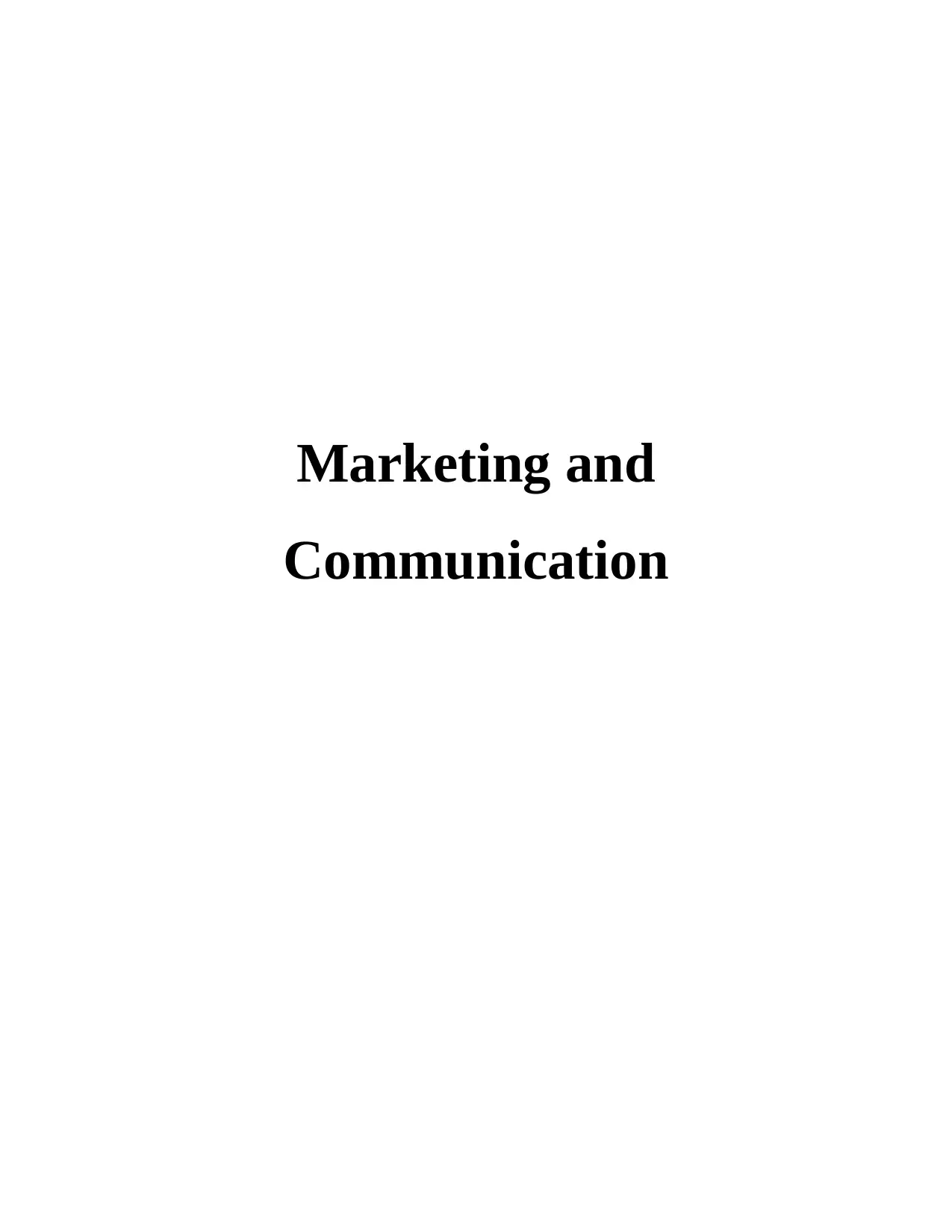
Marketing and
Communication
Communication
Paraphrase This Document
Need a fresh take? Get an instant paraphrase of this document with our AI Paraphraser
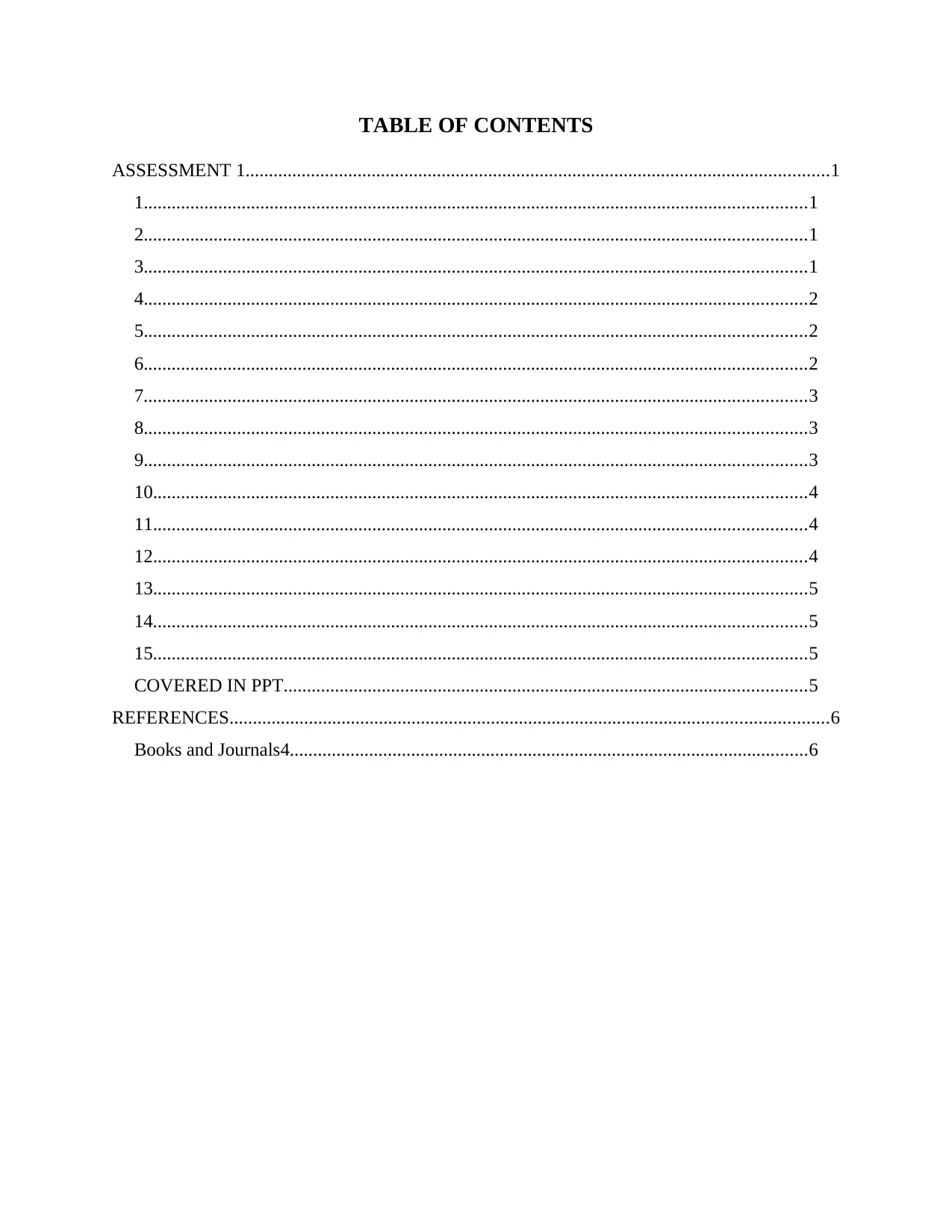
TABLE OF CONTENTS
ASSESSMENT 1.............................................................................................................................1
1..............................................................................................................................................1
2..............................................................................................................................................1
3..............................................................................................................................................1
4..............................................................................................................................................2
5..............................................................................................................................................2
6..............................................................................................................................................2
7..............................................................................................................................................3
8..............................................................................................................................................3
9..............................................................................................................................................3
10............................................................................................................................................4
11............................................................................................................................................4
12............................................................................................................................................4
13............................................................................................................................................5
14............................................................................................................................................5
15............................................................................................................................................5
COVERED IN PPT................................................................................................................5
REFERENCES................................................................................................................................6
Books and Journals4...............................................................................................................6
ASSESSMENT 1.............................................................................................................................1
1..............................................................................................................................................1
2..............................................................................................................................................1
3..............................................................................................................................................1
4..............................................................................................................................................2
5..............................................................................................................................................2
6..............................................................................................................................................2
7..............................................................................................................................................3
8..............................................................................................................................................3
9..............................................................................................................................................3
10............................................................................................................................................4
11............................................................................................................................................4
12............................................................................................................................................4
13............................................................................................................................................5
14............................................................................................................................................5
15............................................................................................................................................5
COVERED IN PPT................................................................................................................5
REFERENCES................................................................................................................................6
Books and Journals4...............................................................................................................6
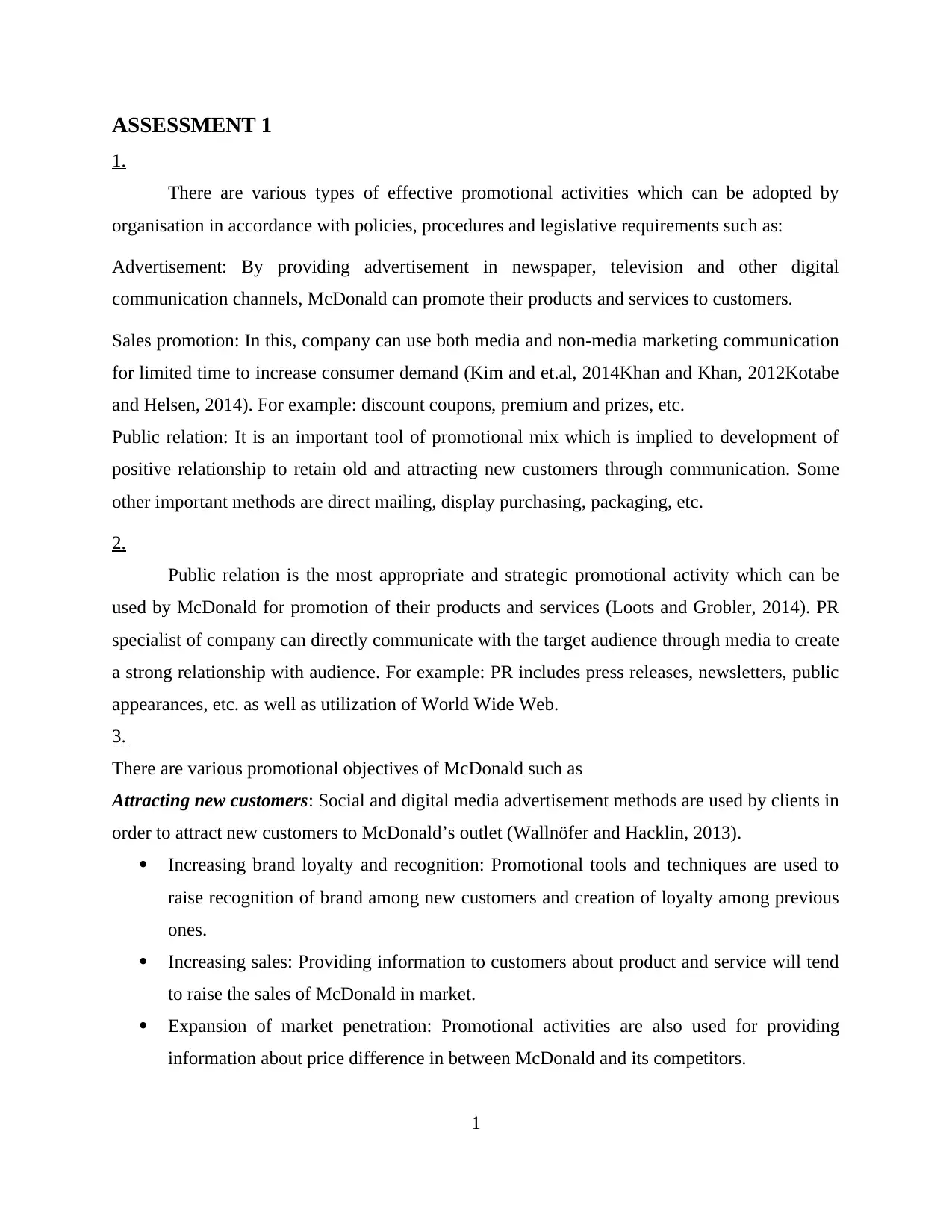
ASSESSMENT 1
1.
There are various types of effective promotional activities which can be adopted by
organisation in accordance with policies, procedures and legislative requirements such as:
Advertisement: By providing advertisement in newspaper, television and other digital
communication channels, McDonald can promote their products and services to customers.
Sales promotion: In this, company can use both media and non-media marketing communication
for limited time to increase consumer demand (Kim and et.al, 2014Khan and Khan, 2012Kotabe
and Helsen, 2014). For example: discount coupons, premium and prizes, etc.
Public relation: It is an important tool of promotional mix which is implied to development of
positive relationship to retain old and attracting new customers through communication. Some
other important methods are direct mailing, display purchasing, packaging, etc.
2.
Public relation is the most appropriate and strategic promotional activity which can be
used by McDonald for promotion of their products and services (Loots and Grobler, 2014). PR
specialist of company can directly communicate with the target audience through media to create
a strong relationship with audience. For example: PR includes press releases, newsletters, public
appearances, etc. as well as utilization of World Wide Web.
3.
There are various promotional objectives of McDonald such as
Attracting new customers: Social and digital media advertisement methods are used by clients in
order to attract new customers to McDonald’s outlet (Wallnöfer and Hacklin, 2013).
Increasing brand loyalty and recognition: Promotional tools and techniques are used to
raise recognition of brand among new customers and creation of loyalty among previous
ones.
Increasing sales: Providing information to customers about product and service will tend
to raise the sales of McDonald in market.
Expansion of market penetration: Promotional activities are also used for providing
information about price difference in between McDonald and its competitors.
1
1.
There are various types of effective promotional activities which can be adopted by
organisation in accordance with policies, procedures and legislative requirements such as:
Advertisement: By providing advertisement in newspaper, television and other digital
communication channels, McDonald can promote their products and services to customers.
Sales promotion: In this, company can use both media and non-media marketing communication
for limited time to increase consumer demand (Kim and et.al, 2014Khan and Khan, 2012Kotabe
and Helsen, 2014). For example: discount coupons, premium and prizes, etc.
Public relation: It is an important tool of promotional mix which is implied to development of
positive relationship to retain old and attracting new customers through communication. Some
other important methods are direct mailing, display purchasing, packaging, etc.
2.
Public relation is the most appropriate and strategic promotional activity which can be
used by McDonald for promotion of their products and services (Loots and Grobler, 2014). PR
specialist of company can directly communicate with the target audience through media to create
a strong relationship with audience. For example: PR includes press releases, newsletters, public
appearances, etc. as well as utilization of World Wide Web.
3.
There are various promotional objectives of McDonald such as
Attracting new customers: Social and digital media advertisement methods are used by clients in
order to attract new customers to McDonald’s outlet (Wallnöfer and Hacklin, 2013).
Increasing brand loyalty and recognition: Promotional tools and techniques are used to
raise recognition of brand among new customers and creation of loyalty among previous
ones.
Increasing sales: Providing information to customers about product and service will tend
to raise the sales of McDonald in market.
Expansion of market penetration: Promotional activities are also used for providing
information about price difference in between McDonald and its competitors.
1
⊘ This is a preview!⊘
Do you want full access?
Subscribe today to unlock all pages.

Trusted by 1+ million students worldwide
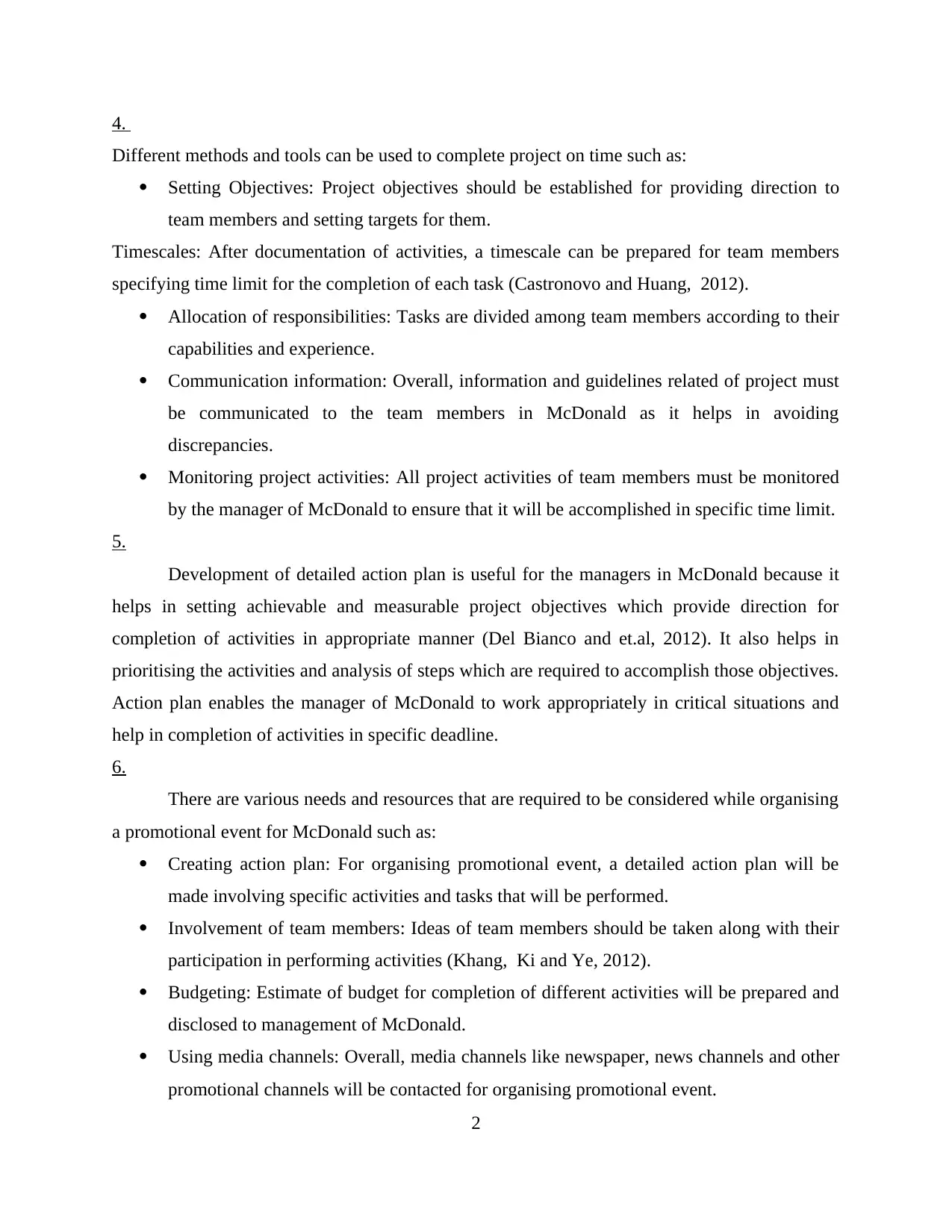
4.
Different methods and tools can be used to complete project on time such as:
Setting Objectives: Project objectives should be established for providing direction to
team members and setting targets for them.
Timescales: After documentation of activities, a timescale can be prepared for team members
specifying time limit for the completion of each task (Castronovo and Huang, 2012).
Allocation of responsibilities: Tasks are divided among team members according to their
capabilities and experience.
Communication information: Overall, information and guidelines related of project must
be communicated to the team members in McDonald as it helps in avoiding
discrepancies.
Monitoring project activities: All project activities of team members must be monitored
by the manager of McDonald to ensure that it will be accomplished in specific time limit.
5.
Development of detailed action plan is useful for the managers in McDonald because it
helps in setting achievable and measurable project objectives which provide direction for
completion of activities in appropriate manner (Del Bianco and et.al, 2012). It also helps in
prioritising the activities and analysis of steps which are required to accomplish those objectives.
Action plan enables the manager of McDonald to work appropriately in critical situations and
help in completion of activities in specific deadline.
6.
There are various needs and resources that are required to be considered while organising
a promotional event for McDonald such as:
Creating action plan: For organising promotional event, a detailed action plan will be
made involving specific activities and tasks that will be performed.
Involvement of team members: Ideas of team members should be taken along with their
participation in performing activities (Khang, Ki and Ye, 2012).
Budgeting: Estimate of budget for completion of different activities will be prepared and
disclosed to management of McDonald.
Using media channels: Overall, media channels like newspaper, news channels and other
promotional channels will be contacted for organising promotional event.
2
Different methods and tools can be used to complete project on time such as:
Setting Objectives: Project objectives should be established for providing direction to
team members and setting targets for them.
Timescales: After documentation of activities, a timescale can be prepared for team members
specifying time limit for the completion of each task (Castronovo and Huang, 2012).
Allocation of responsibilities: Tasks are divided among team members according to their
capabilities and experience.
Communication information: Overall, information and guidelines related of project must
be communicated to the team members in McDonald as it helps in avoiding
discrepancies.
Monitoring project activities: All project activities of team members must be monitored
by the manager of McDonald to ensure that it will be accomplished in specific time limit.
5.
Development of detailed action plan is useful for the managers in McDonald because it
helps in setting achievable and measurable project objectives which provide direction for
completion of activities in appropriate manner (Del Bianco and et.al, 2012). It also helps in
prioritising the activities and analysis of steps which are required to accomplish those objectives.
Action plan enables the manager of McDonald to work appropriately in critical situations and
help in completion of activities in specific deadline.
6.
There are various needs and resources that are required to be considered while organising
a promotional event for McDonald such as:
Creating action plan: For organising promotional event, a detailed action plan will be
made involving specific activities and tasks that will be performed.
Involvement of team members: Ideas of team members should be taken along with their
participation in performing activities (Khang, Ki and Ye, 2012).
Budgeting: Estimate of budget for completion of different activities will be prepared and
disclosed to management of McDonald.
Using media channels: Overall, media channels like newspaper, news channels and other
promotional channels will be contacted for organising promotional event.
2
Paraphrase This Document
Need a fresh take? Get an instant paraphrase of this document with our AI Paraphraser
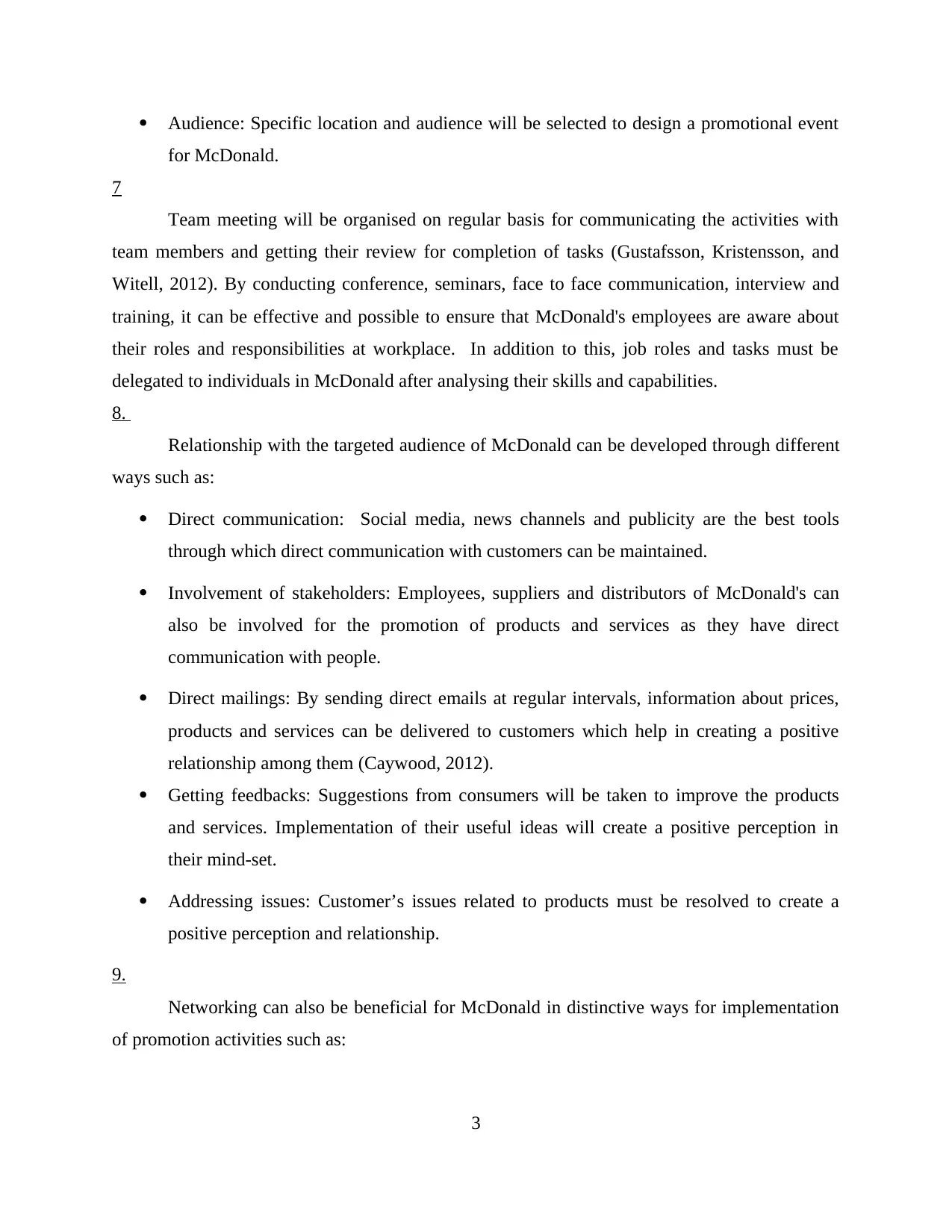
Audience: Specific location and audience will be selected to design a promotional event
for McDonald.
7
Team meeting will be organised on regular basis for communicating the activities with
team members and getting their review for completion of tasks (Gustafsson, Kristensson, and
Witell, 2012). By conducting conference, seminars, face to face communication, interview and
training, it can be effective and possible to ensure that McDonald's employees are aware about
their roles and responsibilities at workplace. In addition to this, job roles and tasks must be
delegated to individuals in McDonald after analysing their skills and capabilities.
8.
Relationship with the targeted audience of McDonald can be developed through different
ways such as:
Direct communication: Social media, news channels and publicity are the best tools
through which direct communication with customers can be maintained.
Involvement of stakeholders: Employees, suppliers and distributors of McDonald's can
also be involved for the promotion of products and services as they have direct
communication with people.
Direct mailings: By sending direct emails at regular intervals, information about prices,
products and services can be delivered to customers which help in creating a positive
relationship among them (Caywood, 2012).
Getting feedbacks: Suggestions from consumers will be taken to improve the products
and services. Implementation of their useful ideas will create a positive perception in
their mind-set.
Addressing issues: Customer’s issues related to products must be resolved to create a
positive perception and relationship.
9.
Networking can also be beneficial for McDonald in distinctive ways for implementation
of promotion activities such as:
3
for McDonald.
7
Team meeting will be organised on regular basis for communicating the activities with
team members and getting their review for completion of tasks (Gustafsson, Kristensson, and
Witell, 2012). By conducting conference, seminars, face to face communication, interview and
training, it can be effective and possible to ensure that McDonald's employees are aware about
their roles and responsibilities at workplace. In addition to this, job roles and tasks must be
delegated to individuals in McDonald after analysing their skills and capabilities.
8.
Relationship with the targeted audience of McDonald can be developed through different
ways such as:
Direct communication: Social media, news channels and publicity are the best tools
through which direct communication with customers can be maintained.
Involvement of stakeholders: Employees, suppliers and distributors of McDonald's can
also be involved for the promotion of products and services as they have direct
communication with people.
Direct mailings: By sending direct emails at regular intervals, information about prices,
products and services can be delivered to customers which help in creating a positive
relationship among them (Caywood, 2012).
Getting feedbacks: Suggestions from consumers will be taken to improve the products
and services. Implementation of their useful ideas will create a positive perception in
their mind-set.
Addressing issues: Customer’s issues related to products must be resolved to create a
positive perception and relationship.
9.
Networking can also be beneficial for McDonald in distinctive ways for implementation
of promotion activities such as:
3
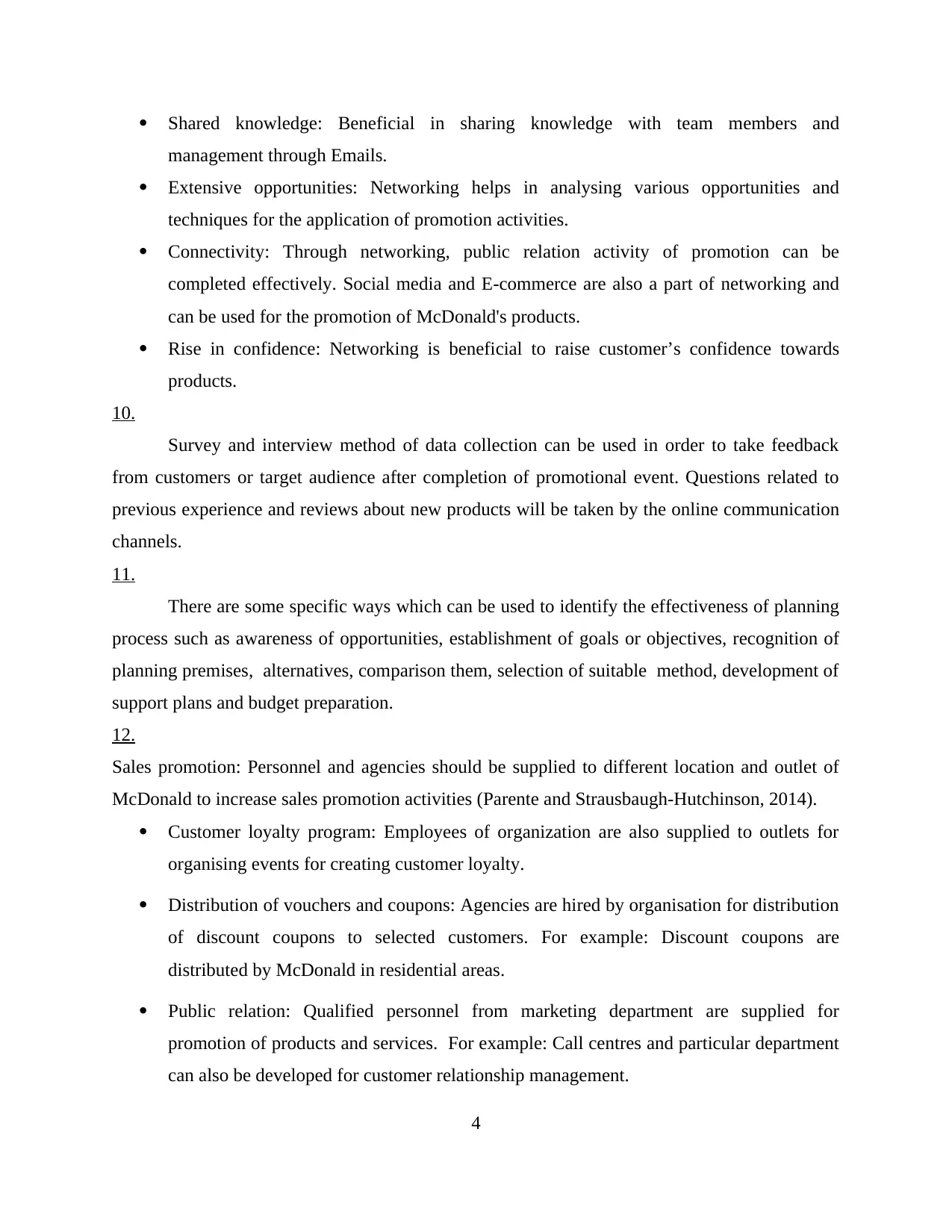
Shared knowledge: Beneficial in sharing knowledge with team members and
management through Emails.
Extensive opportunities: Networking helps in analysing various opportunities and
techniques for the application of promotion activities.
Connectivity: Through networking, public relation activity of promotion can be
completed effectively. Social media and E-commerce are also a part of networking and
can be used for the promotion of McDonald's products.
Rise in confidence: Networking is beneficial to raise customer’s confidence towards
products.
10.
Survey and interview method of data collection can be used in order to take feedback
from customers or target audience after completion of promotional event. Questions related to
previous experience and reviews about new products will be taken by the online communication
channels.
11.
There are some specific ways which can be used to identify the effectiveness of planning
process such as awareness of opportunities, establishment of goals or objectives, recognition of
planning premises, alternatives, comparison them, selection of suitable method, development of
support plans and budget preparation.
12.
Sales promotion: Personnel and agencies should be supplied to different location and outlet of
McDonald to increase sales promotion activities (Parente and Strausbaugh-Hutchinson, 2014).
Customer loyalty program: Employees of organization are also supplied to outlets for
organising events for creating customer loyalty.
Distribution of vouchers and coupons: Agencies are hired by organisation for distribution
of discount coupons to selected customers. For example: Discount coupons are
distributed by McDonald in residential areas.
Public relation: Qualified personnel from marketing department are supplied for
promotion of products and services. For example: Call centres and particular department
can also be developed for customer relationship management.
4
management through Emails.
Extensive opportunities: Networking helps in analysing various opportunities and
techniques for the application of promotion activities.
Connectivity: Through networking, public relation activity of promotion can be
completed effectively. Social media and E-commerce are also a part of networking and
can be used for the promotion of McDonald's products.
Rise in confidence: Networking is beneficial to raise customer’s confidence towards
products.
10.
Survey and interview method of data collection can be used in order to take feedback
from customers or target audience after completion of promotional event. Questions related to
previous experience and reviews about new products will be taken by the online communication
channels.
11.
There are some specific ways which can be used to identify the effectiveness of planning
process such as awareness of opportunities, establishment of goals or objectives, recognition of
planning premises, alternatives, comparison them, selection of suitable method, development of
support plans and budget preparation.
12.
Sales promotion: Personnel and agencies should be supplied to different location and outlet of
McDonald to increase sales promotion activities (Parente and Strausbaugh-Hutchinson, 2014).
Customer loyalty program: Employees of organization are also supplied to outlets for
organising events for creating customer loyalty.
Distribution of vouchers and coupons: Agencies are hired by organisation for distribution
of discount coupons to selected customers. For example: Discount coupons are
distributed by McDonald in residential areas.
Public relation: Qualified personnel from marketing department are supplied for
promotion of products and services. For example: Call centres and particular department
can also be developed for customer relationship management.
4
⊘ This is a preview!⊘
Do you want full access?
Subscribe today to unlock all pages.

Trusted by 1+ million students worldwide
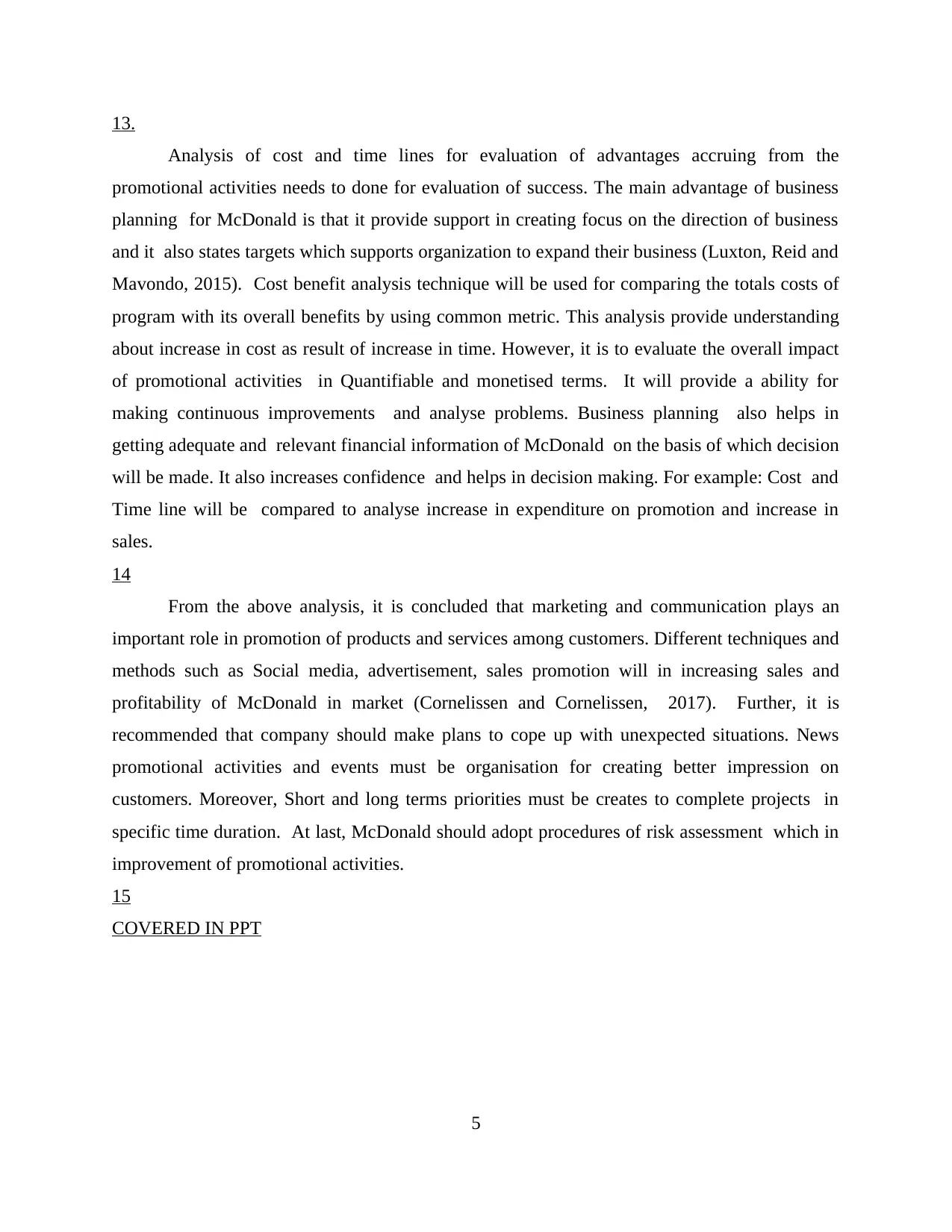
13.
Analysis of cost and time lines for evaluation of advantages accruing from the
promotional activities needs to done for evaluation of success. The main advantage of business
planning for McDonald is that it provide support in creating focus on the direction of business
and it also states targets which supports organization to expand their business (Luxton, Reid and
Mavondo, 2015). Cost benefit analysis technique will be used for comparing the totals costs of
program with its overall benefits by using common metric. This analysis provide understanding
about increase in cost as result of increase in time. However, it is to evaluate the overall impact
of promotional activities in Quantifiable and monetised terms. It will provide a ability for
making continuous improvements and analyse problems. Business planning also helps in
getting adequate and relevant financial information of McDonald on the basis of which decision
will be made. It also increases confidence and helps in decision making. For example: Cost and
Time line will be compared to analyse increase in expenditure on promotion and increase in
sales.
14
From the above analysis, it is concluded that marketing and communication plays an
important role in promotion of products and services among customers. Different techniques and
methods such as Social media, advertisement, sales promotion will in increasing sales and
profitability of McDonald in market (Cornelissen and Cornelissen, 2017). Further, it is
recommended that company should make plans to cope up with unexpected situations. News
promotional activities and events must be organisation for creating better impression on
customers. Moreover, Short and long terms priorities must be creates to complete projects in
specific time duration. At last, McDonald should adopt procedures of risk assessment which in
improvement of promotional activities.
15
COVERED IN PPT
5
Analysis of cost and time lines for evaluation of advantages accruing from the
promotional activities needs to done for evaluation of success. The main advantage of business
planning for McDonald is that it provide support in creating focus on the direction of business
and it also states targets which supports organization to expand their business (Luxton, Reid and
Mavondo, 2015). Cost benefit analysis technique will be used for comparing the totals costs of
program with its overall benefits by using common metric. This analysis provide understanding
about increase in cost as result of increase in time. However, it is to evaluate the overall impact
of promotional activities in Quantifiable and monetised terms. It will provide a ability for
making continuous improvements and analyse problems. Business planning also helps in
getting adequate and relevant financial information of McDonald on the basis of which decision
will be made. It also increases confidence and helps in decision making. For example: Cost and
Time line will be compared to analyse increase in expenditure on promotion and increase in
sales.
14
From the above analysis, it is concluded that marketing and communication plays an
important role in promotion of products and services among customers. Different techniques and
methods such as Social media, advertisement, sales promotion will in increasing sales and
profitability of McDonald in market (Cornelissen and Cornelissen, 2017). Further, it is
recommended that company should make plans to cope up with unexpected situations. News
promotional activities and events must be organisation for creating better impression on
customers. Moreover, Short and long terms priorities must be creates to complete projects in
specific time duration. At last, McDonald should adopt procedures of risk assessment which in
improvement of promotional activities.
15
COVERED IN PPT
5
Paraphrase This Document
Need a fresh take? Get an instant paraphrase of this document with our AI Paraphraser
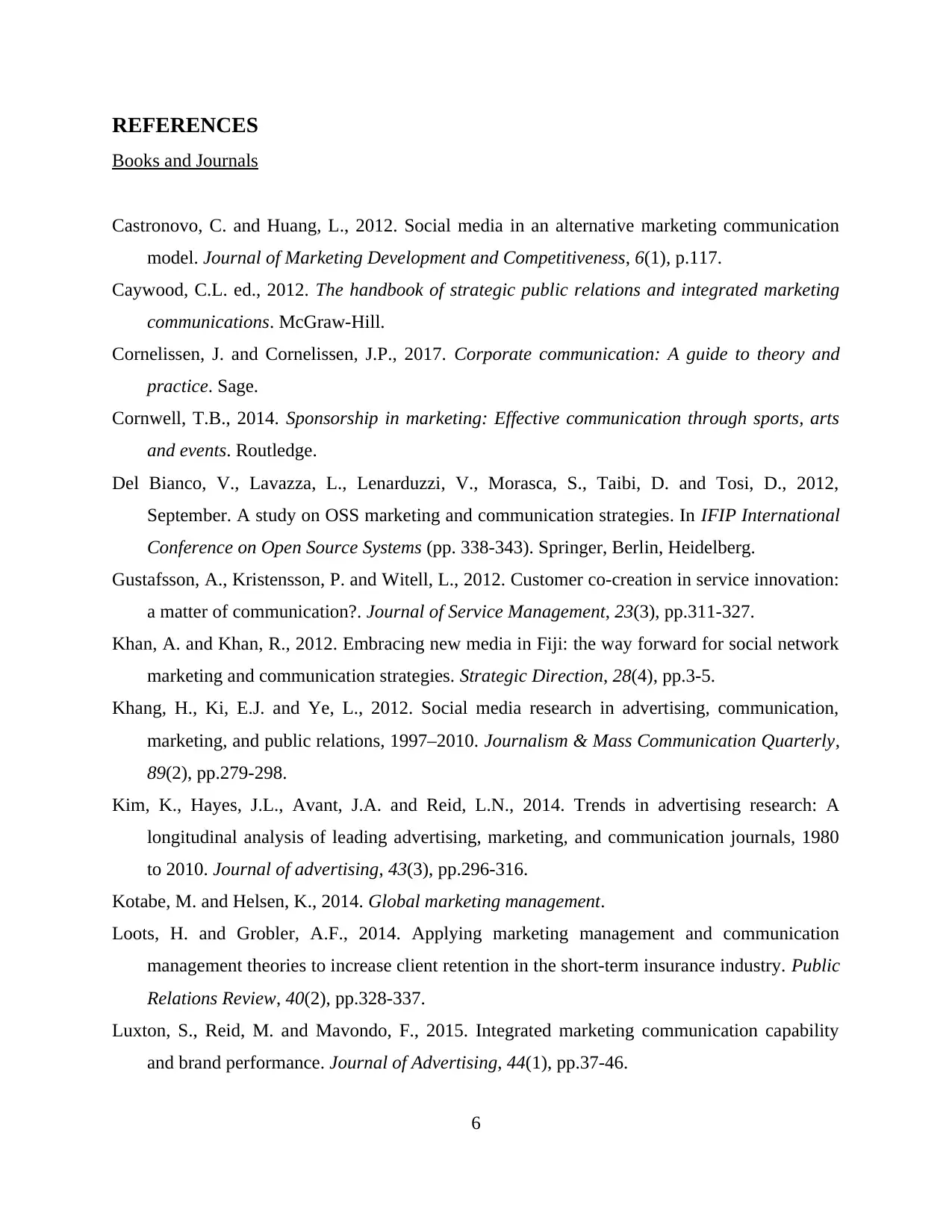
REFERENCES
Books and Journals
Castronovo, C. and Huang, L., 2012. Social media in an alternative marketing communication
model. Journal of Marketing Development and Competitiveness, 6(1), p.117.
Caywood, C.L. ed., 2012. The handbook of strategic public relations and integrated marketing
communications. McGraw-Hill.
Cornelissen, J. and Cornelissen, J.P., 2017. Corporate communication: A guide to theory and
practice. Sage.
Cornwell, T.B., 2014. Sponsorship in marketing: Effective communication through sports, arts
and events. Routledge.
Del Bianco, V., Lavazza, L., Lenarduzzi, V., Morasca, S., Taibi, D. and Tosi, D., 2012,
September. A study on OSS marketing and communication strategies. In IFIP International
Conference on Open Source Systems (pp. 338-343). Springer, Berlin, Heidelberg.
Gustafsson, A., Kristensson, P. and Witell, L., 2012. Customer co-creation in service innovation:
a matter of communication?. Journal of Service Management, 23(3), pp.311-327.
Khan, A. and Khan, R., 2012. Embracing new media in Fiji: the way forward for social network
marketing and communication strategies. Strategic Direction, 28(4), pp.3-5.
Khang, H., Ki, E.J. and Ye, L., 2012. Social media research in advertising, communication,
marketing, and public relations, 1997–2010. Journalism & Mass Communication Quarterly,
89(2), pp.279-298.
Kim, K., Hayes, J.L., Avant, J.A. and Reid, L.N., 2014. Trends in advertising research: A
longitudinal analysis of leading advertising, marketing, and communication journals, 1980
to 2010. Journal of advertising, 43(3), pp.296-316.
Kotabe, M. and Helsen, K., 2014. Global marketing management.
Loots, H. and Grobler, A.F., 2014. Applying marketing management and communication
management theories to increase client retention in the short-term insurance industry. Public
Relations Review, 40(2), pp.328-337.
Luxton, S., Reid, M. and Mavondo, F., 2015. Integrated marketing communication capability
and brand performance. Journal of Advertising, 44(1), pp.37-46.
6
Books and Journals
Castronovo, C. and Huang, L., 2012. Social media in an alternative marketing communication
model. Journal of Marketing Development and Competitiveness, 6(1), p.117.
Caywood, C.L. ed., 2012. The handbook of strategic public relations and integrated marketing
communications. McGraw-Hill.
Cornelissen, J. and Cornelissen, J.P., 2017. Corporate communication: A guide to theory and
practice. Sage.
Cornwell, T.B., 2014. Sponsorship in marketing: Effective communication through sports, arts
and events. Routledge.
Del Bianco, V., Lavazza, L., Lenarduzzi, V., Morasca, S., Taibi, D. and Tosi, D., 2012,
September. A study on OSS marketing and communication strategies. In IFIP International
Conference on Open Source Systems (pp. 338-343). Springer, Berlin, Heidelberg.
Gustafsson, A., Kristensson, P. and Witell, L., 2012. Customer co-creation in service innovation:
a matter of communication?. Journal of Service Management, 23(3), pp.311-327.
Khan, A. and Khan, R., 2012. Embracing new media in Fiji: the way forward for social network
marketing and communication strategies. Strategic Direction, 28(4), pp.3-5.
Khang, H., Ki, E.J. and Ye, L., 2012. Social media research in advertising, communication,
marketing, and public relations, 1997–2010. Journalism & Mass Communication Quarterly,
89(2), pp.279-298.
Kim, K., Hayes, J.L., Avant, J.A. and Reid, L.N., 2014. Trends in advertising research: A
longitudinal analysis of leading advertising, marketing, and communication journals, 1980
to 2010. Journal of advertising, 43(3), pp.296-316.
Kotabe, M. and Helsen, K., 2014. Global marketing management.
Loots, H. and Grobler, A.F., 2014. Applying marketing management and communication
management theories to increase client retention in the short-term insurance industry. Public
Relations Review, 40(2), pp.328-337.
Luxton, S., Reid, M. and Mavondo, F., 2015. Integrated marketing communication capability
and brand performance. Journal of Advertising, 44(1), pp.37-46.
6
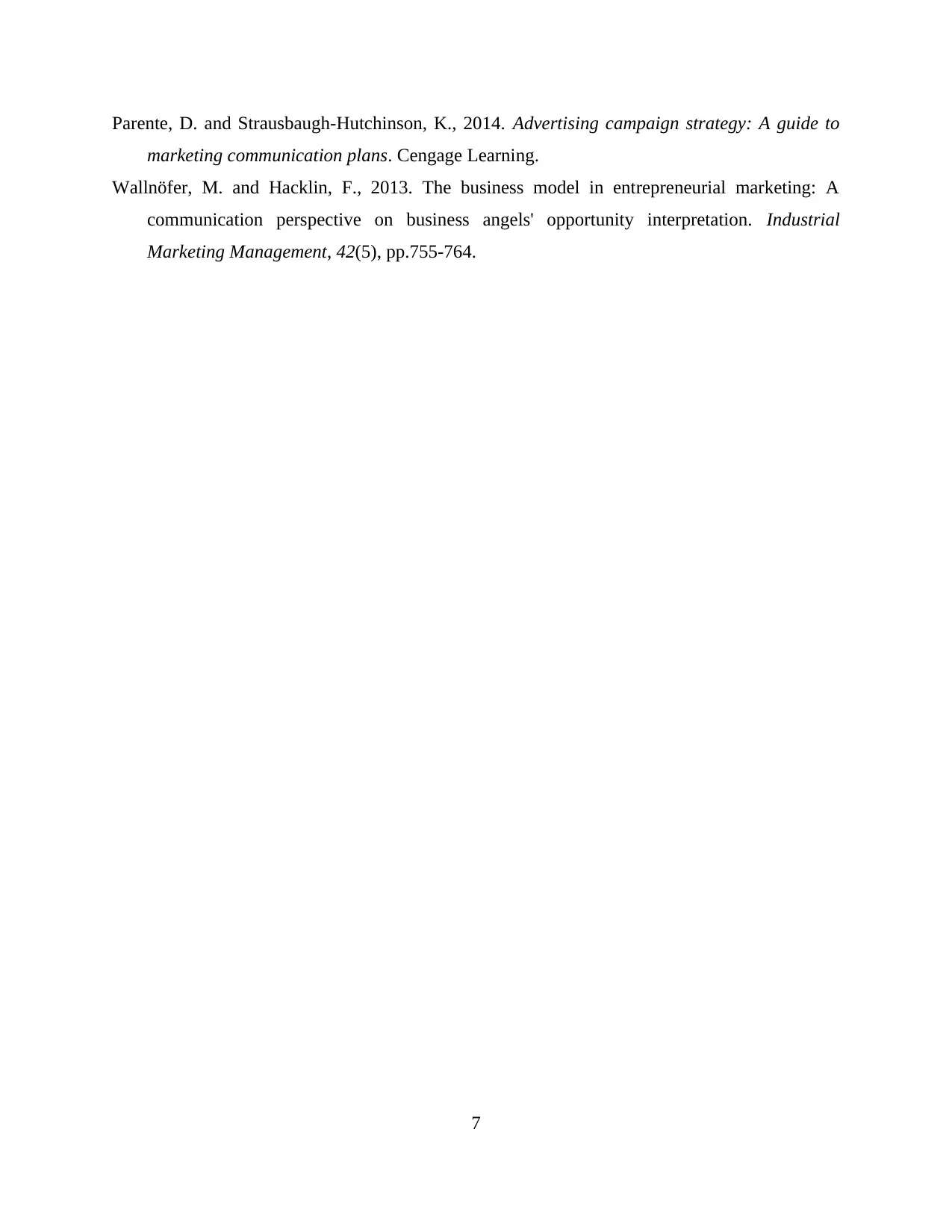
Parente, D. and Strausbaugh-Hutchinson, K., 2014. Advertising campaign strategy: A guide to
marketing communication plans. Cengage Learning.
Wallnöfer, M. and Hacklin, F., 2013. The business model in entrepreneurial marketing: A
communication perspective on business angels' opportunity interpretation. Industrial
Marketing Management, 42(5), pp.755-764.
7
marketing communication plans. Cengage Learning.
Wallnöfer, M. and Hacklin, F., 2013. The business model in entrepreneurial marketing: A
communication perspective on business angels' opportunity interpretation. Industrial
Marketing Management, 42(5), pp.755-764.
7
⊘ This is a preview!⊘
Do you want full access?
Subscribe today to unlock all pages.

Trusted by 1+ million students worldwide
1 out of 9
Related Documents
Your All-in-One AI-Powered Toolkit for Academic Success.
+13062052269
info@desklib.com
Available 24*7 on WhatsApp / Email
![[object Object]](/_next/static/media/star-bottom.7253800d.svg)
Unlock your academic potential
Copyright © 2020–2025 A2Z Services. All Rights Reserved. Developed and managed by ZUCOL.





